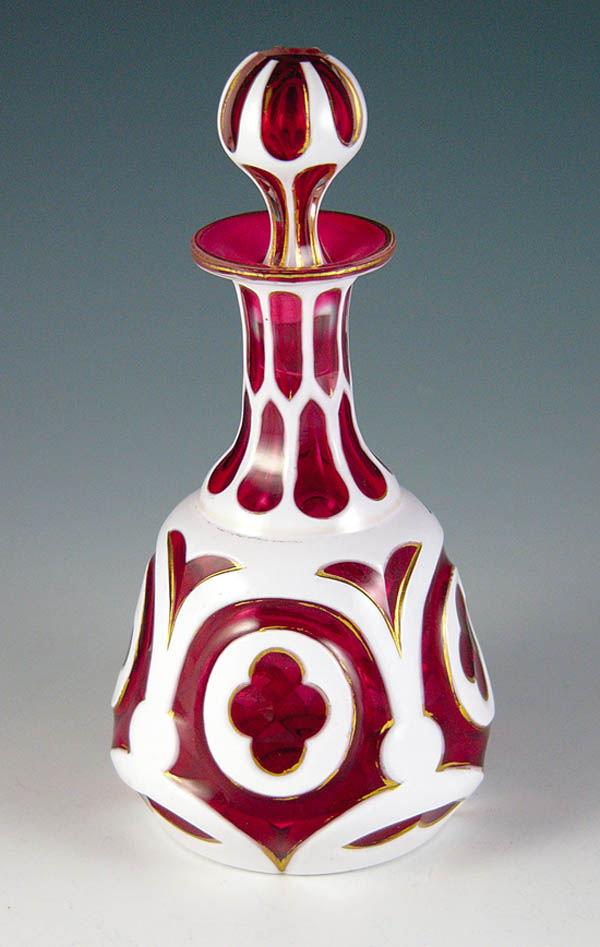Glistening Glory: Collectible Cased Glass
Smack Dab In The Middle: Design Trends Of The Mid-20th Century
Glass. While it is being formed, you can bend it and you can shape it. You can mold, slump, fuse, or crackle it. Pressed glass? Check. Blown glass? That's on the list, too. Plus, there's sculpted glass, engraved glass, woven glass, and, of course, cut glass.
And then there's cased glass.
The "look" of cased glass can easily be captured in the mind's eye. Contrasting layers of varied glass colors, (often cranberry and white, cobalt and white, or either with clear), are fused together. Patterns in the exterior layer are "cut to" the inner layer, revealing the color variance beneath. But, in keeping with the Victorian taste for embellishment, the gloss goes even further. Often, the pieces include gold detailing on the exterior layer, enameled illustrations (usually floral), and, in especially elaborate designs, dangling clear arrowhead prisms, faceted to catch the light.
The interior layer of cased glass is, in effect, encased in the exterior, both layers of equal thickness. The process is repeated for any additional layers.
Cutaways in the outer cased glass layer expose the inner contrast. The cutaways, achieved through grinding, are often repeated geometric or nature motifs, their edges defined with gold striping. Although sometimes referred to as "cameos," that term is not really technically accurate. A "cameo" is the raised portion remaining after a surface glass layer, often opaque white, has been hand-carved, acid-etched, or "cut" with the use of mechanical grinding wheel.
In the strictest glassblower's definition of cased glass, a piece of one color has already been fashioned, and the new color layer is blown inside it. In the United States, an alternate term for "cased" glass is "plated" glass. Common throughout Bohemia from the early 1800s onward, cased glass made its way to France in the 1820s, and to England by the mid-1800s.
The terms "overlay glass" and "cased glass" are often used interchangeably, and there's really no contradiction in the eventual outcome. Technically, however, "overlay" refers to layering glass of different colors during the glassblowing process, resulting in the cased effect. "Casing," as noted, refers to blowing a new glass layer within an original completed layer. In both cases, the layers are then fused together.
Among the most popular manifestations of cased glass: decanters, tumblers, goblets, cruets, bowls, plates, vases, epergnes, dresser boxes, perfume bottles, and even pendants. Most imposing are "mantel lustres," (also known as "spill vases"), oversize open-top vases adorned with prisms.
The upper-class Victorian drawing room was chock-a-block with "stuff." Ornate velvet settees and loveseats jostled for floor space, as did tables crowded with curios of every shape, size, and provenance. Amidst all the decorative clutter, cased glass, a festival of larger-than-life ornamentation, seemed right at home.
More thought is required for the placement of cased glass in the modern living space, where rooms are less thematically decorated, if no less crowded. Fortunately, cased glass objects seem to naturally find the perfect spot to dominate the conversation. A single, massive mantel lustre (on the mantel, naturally), can be breathtaking. A ledge lineup of ruby-and-white decanters and tumblers can make a novel and effective visual contribution to any décor. Bringing cased glass to the forefront is key; it's most definitely not a decorating afterthought.
Skillfully executed and lavishly decorated, cased glass objects stand as an historical tribute to a very specialized application of the glassmaker's craft. These are, quite simply, beautiful works of art. Decades and decades after debuting, the brilliance of cased glass continues to dazzle. In the giant candybox of Victorian ornamentation, cased glass is among the tastiest, and most visually appetizing, of offerings.
Donald-Brian Johnson is the co-author of numerous Schiffer books on design and collectibles, including "Postwar Pop," a collection of his columns. Please address inquiries to: donaldbrian@msn.com.

Donald-Brian Johnson
Donald-Brian Johnson is a nationwide columnist, and the co-author of numerous Schiffer books on design and collectibles. His most recent, "Postwar Pop," is a collection of his columns.














